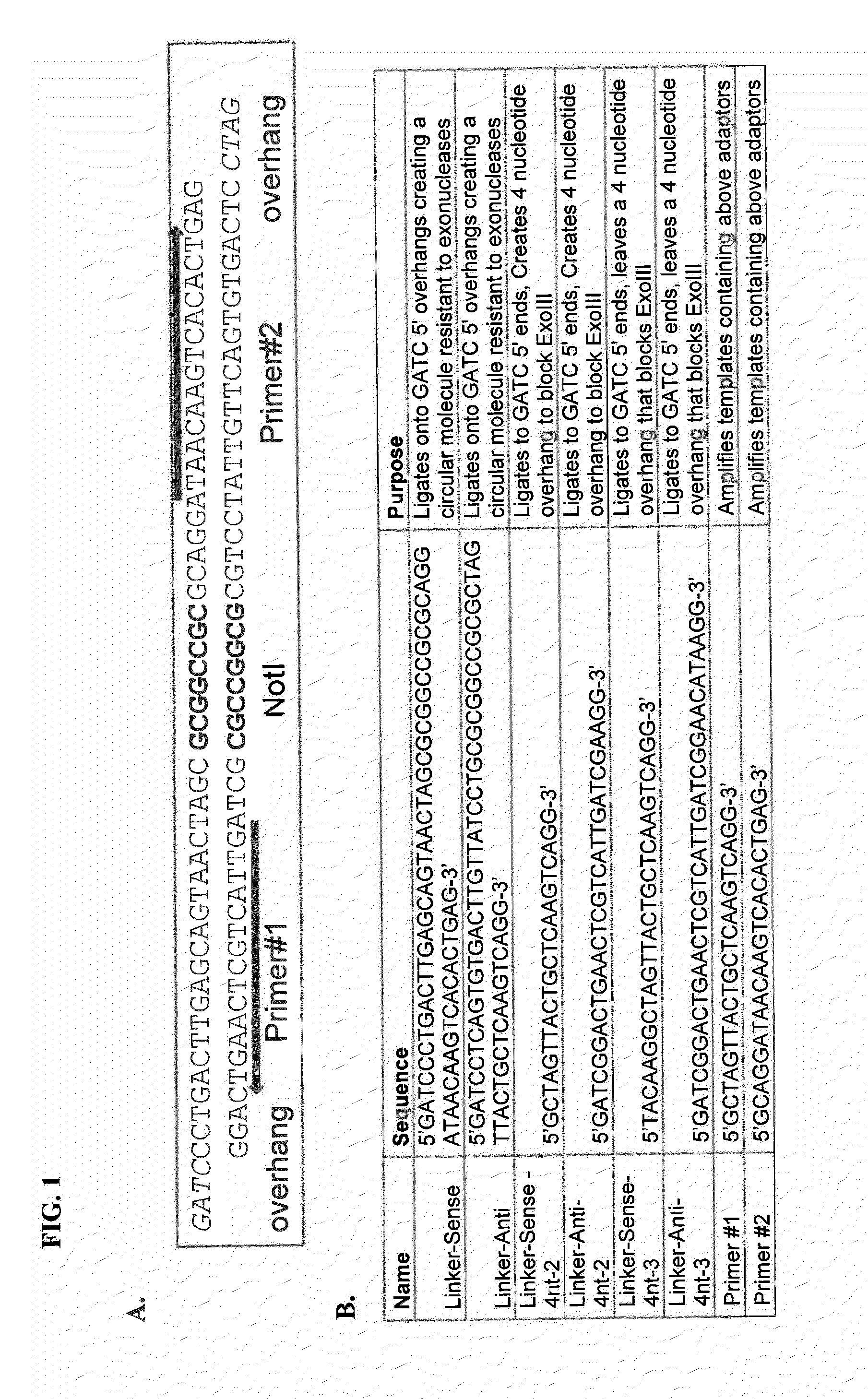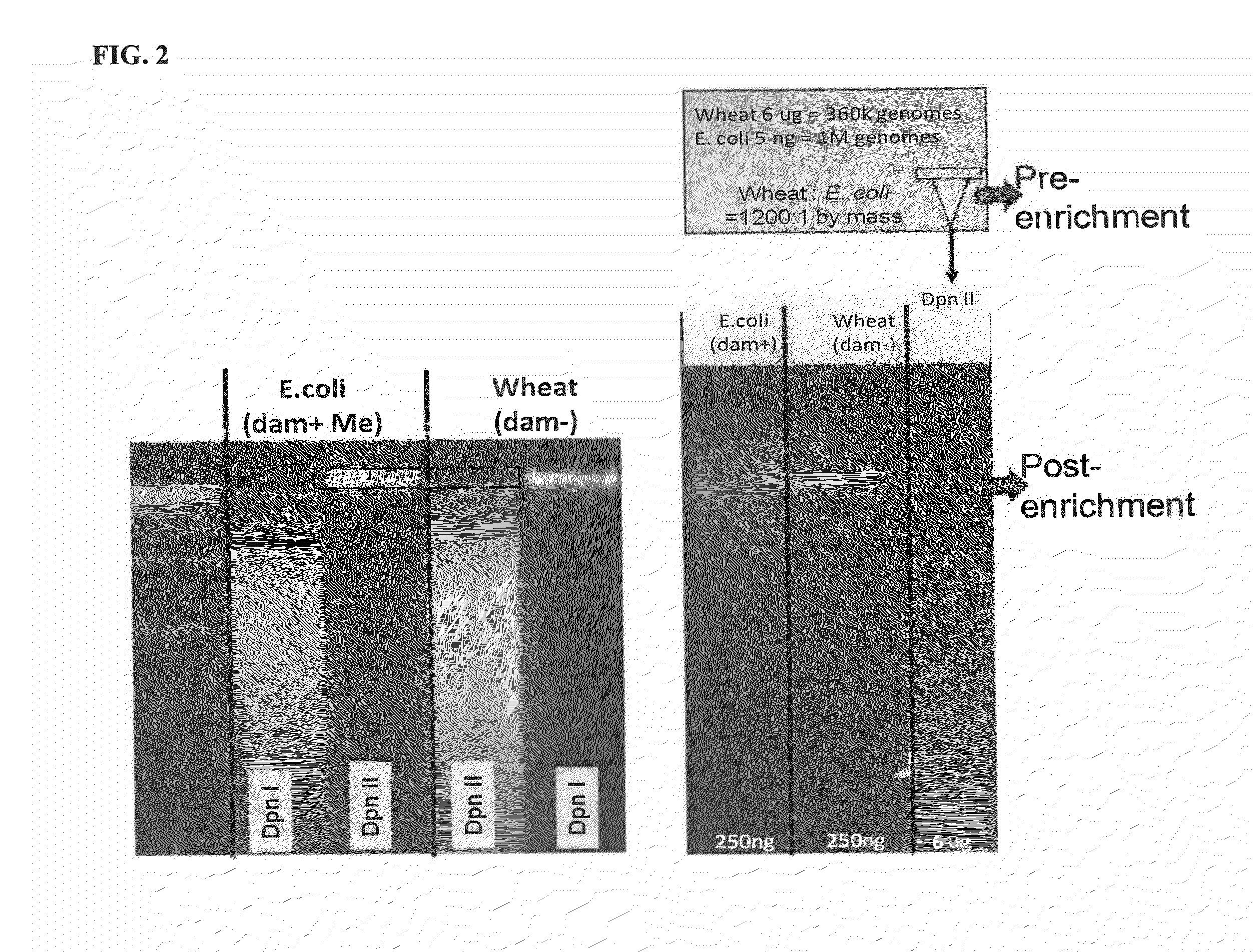Methods and Compositions for Segregating Target Nucleic Acid from Mixed Nucleic Acid Samples
a nucleic acid and target technology, applied in the field of methods and compositions for segregating a target nucleic acid from a mixed nucleic acid sample, can solve the problems of difficult detection of a biological threat, difficult to isolate or amplify the target nucleic acid, and insufficient comprehensive solution for separation and isolation of bacterial dna from a mixed sample containing eukaryotic dna, etc., to achieve rapid and efficient isolation and identification of prokary
- Summary
- Abstract
- Description
- Claims
- Application Information
AI Technical Summary
Benefits of technology
Problems solved by technology
Method used
Image
Examples
example 1
[0077]This example provides a general protocol for practicing the epigenetic binder method of the current invention.
[0078]Materials[0079]DNA mixture to be enriched for bacterial genomic DNA[0080]Methyl binder[0081]Biotinylated DpnI binder[0082]Biotinylated αN6mA mAb[0083]Resuspension buffer (TE or di water)[0084]mAb Binding buffer (10 mM NaK pH7, 140 mM NaCl, 0.05% Triton X100)[0085]Biotinylated DpnI Binding buffer (10 mM TrisHCl ph7.5, 100 mM NaCl, 0.1% Tween20)[0086]SA-Dynabeads (Dynal Inc)[0087]QiaQuick PCR purification kit (Qiagen, Valencia, Calif.)
[0088]Methods[0089]Choose the mAb if you want to collect single stranded DNA with no sequence dependencies. Choose the DpnI binder if you want to work with double stranded DNA and your target has methylated GATC sites.[0090]Additional reagents include: αN4mA mAb, and other biotinylated restriction enzymes which are anticipated to use the same basic protocol below.[0091]Preparation of beads[0092]Couple DpnI binder to beads[0093]Wash be...
example 2
[0106]This example provides another general protocol for practicing a method of the invention.
[0107]Bead Preparation:
[0108]First, coated magnetic beads are prepared by resuspending magnetic beads by rotation or vortexing. The amount of magnetic beads required (a “working volume”) is calculated based on number of samples needed using the formula: (# samples X 20 ul)+10 ul=working volume. 20 uls of magnetic beads are required per sample. With multiple samples, beads can be prepared in bulk, although it is recommended to account for the volume loss due to pipetting when calculating the working volume of beads needed.
[0109]Next, a working volume of magnetic beads is transferred to a new tube and placed on a magnet for 1-2 min. The resulting supernatant is removed by aspiration with a pipette while the tube is on the magnet. The tube is then removed from the magnet and at least a working volume of wash buffer is added to the inside of the tube where the beads are collected and the mixtur...
example 3
[0118]The following example provides data that one embodiment of the epigenetic-specific digestion method is effective to isolate bacterial DNA from a mixed sample. Example 3 utilizes steps 1 and 3 from Table 4 above.
1. Methylation Selective Digestion
[0119]A mixture was made of DNA from a eukaryotic organism, wheat (Triticum aestivum), and DNA from a bacterium (Escherichia coli)(Table 7). DpnII was used to digest DNA in the mixture containing only GATC sites unmethylated at the N6 position of adenine (Wheat DNA is restricted and not E. coli)(Table 7).
TABLE 7DNA mixtureMixture digestion1.05 ng E. coli DNA2.010X DpnII buffer NEB7.06.0 ug Wheat genomic DNA2.0DpnII 10 u / ul8.0E. coli / wheat mixture8.0nuclease free water8.0E. coli and Wheat DNAmixture20.0 ul
[0120]FIG. 2 shows that methylation selective digestion enables segregation of prokaryotic and eukaryotic DNA. DpnI cuts only DNA methylated at adenines of GATC sites. DpnII cuts only when GATCs are unmethylated. A mixture of bacterial...
PUM
| Property | Measurement | Unit |
|---|---|---|
| pH | aaaaa | aaaaa |
| temperature | aaaaa | aaaaa |
| concentration | aaaaa | aaaaa |
Abstract
Description
Claims
Application Information
 Login to View More
Login to View More - R&D
- Intellectual Property
- Life Sciences
- Materials
- Tech Scout
- Unparalleled Data Quality
- Higher Quality Content
- 60% Fewer Hallucinations
Browse by: Latest US Patents, China's latest patents, Technical Efficacy Thesaurus, Application Domain, Technology Topic, Popular Technical Reports.
© 2025 PatSnap. All rights reserved.Legal|Privacy policy|Modern Slavery Act Transparency Statement|Sitemap|About US| Contact US: help@patsnap.com



